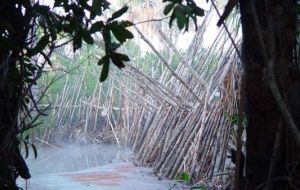MercoPress. South Atlantic News Agency
Brazil: Ancient Amazon Actually Highly Urbanized
 A modern Kuikuro dam, used to help funnel fish into submerged fish weirs
A modern Kuikuro dam, used to help funnel fish into submerged fish weirs Using satellite imagery, scientists have discovered the remains of once densely populated towns in west Brazil, an area that was thought to be virgin forest.
The report in Friday's edition of the journal Sciencedescribes clusters of towns and smaller villages that were connected by complex road networks and were arranged around large central plazas. Researches also discovered signs of farming, wetland management and fish farms in the ancient settlements that are now almost completely covered by rainforest. The tribes living in the newly found settlements, which date back to before the first Europeans arrived in the Upper Xingu region of the Brazilian Amazon in the 15th Century, don't seem to be as sophisticated as well-known cultures like the Maya to the north, but still, their culture was much more complex that anthropologists had believed. Professor Mike Heckenberger, from the University of Florida, in Gainesville, said that, even though the settlements were not cities, this is still urbanism, as "they have quite remarkable planning and self-organisation, more so than many classical examples of what people would call urbanism." The remains are hardly visible, but they could be identified by members of the Kuikuro tribe, who apparently are the direct descendents of those ancient tribes. The scientists used both satellite imagery and GPS navigation in order to uncover the towns, which used to be surrounded by large walls, similar to the ones encountered in medieval European and ancient Greek towns. Heckenberger and colleagues first reported evidence of the culture in 2003, and now they have discovered new details of the ancient civilizations. The local populations declined considerably after Europeans arrived in the 28 prehistoric residential sites. The people that used to live in the towns are believed to have been wiped out when European colonists arrived and brought diseases with them.




Top Comments
Disclaimer & comment rulesCommenting for this story is now closed.
If you have a Facebook account, become a fan and comment on our Facebook Page!